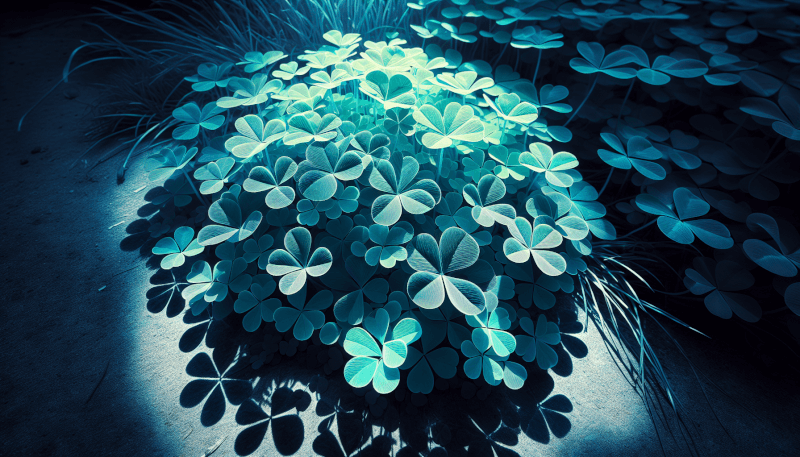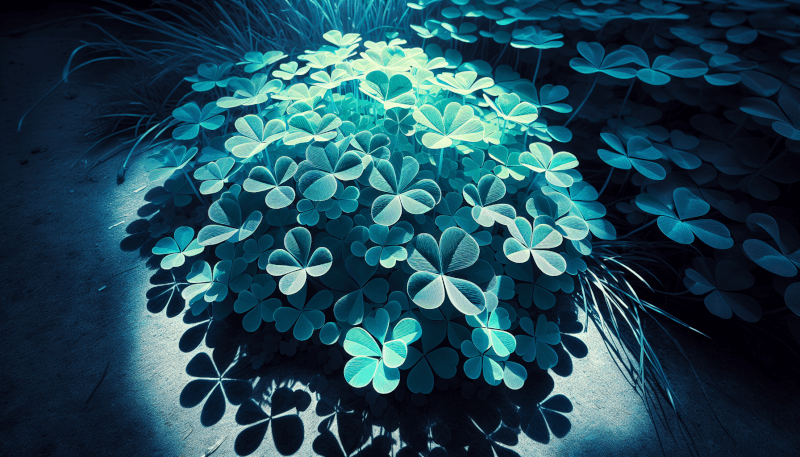If you’ve ever wondered whether clover can thrive in the shade, wonder no more! This article explores the fascinating topic of whether or not clover can grow in shady conditions. You’ll discover the surprising truth about clover’s adaptability and its ability to thrive even in areas with less sunlight. So, if you have a shaded area in your garden or yard and are considering planting clover, keep reading to find out all you need to know about its potential growth in shade.

What is Clover?
Definition of Clover
Clover is a type of herbaceous plant that belongs to the legume family. It is recognized for its trifoliate leaves and small, spherical flower heads. Clover is widely distributed around the world and is known for its ability to fix nitrogen in the soil, making it an important component of forage and cover crops.
Varieties of Clover
There are several varieties of clover that are cultivated for various purposes. Some common varieties include red clover (Trifolium pratense), white clover (Trifolium repens), subterranean clover (Trifolium subterraneum), and crimson clover (Trifolium incarnatum). Each variety has its own specific characteristics and growing requirements.
Characteristics of Clover
Clover plants typically have a prostrate growth habit, with stems that spread along the ground. They have compound leaves, with three leaflets per leaf. The flowers of clover can vary in color, ranging from white to pink or red. Clovers are known to attract pollinators, such as bees, due to their nectar-rich flowers. Additionally, clover has the ability to improve soil health by fixing nitrogen, which is essential for plant growth.
Factors Affecting Clover Growth
Sunlight Requirements
Clover generally thrives in areas with full sunlight. It requires at least six hours of direct sunlight per day to grow and develop properly. Insufficient sunlight can lead to weak, sparse growth and reduced flower production.
Soil Conditions
Clover prefers well-drained soil that is fertile and rich in organic matter. It can tolerate a wide range of soil types, including sandy, loamy, and clay soils. However, soil pH is an important factor to consider for optimal clover growth. Most clover varieties prefer slightly acidic to neutral soil with a pH ranging from 6.0 to 7.0.
Moisture Requirements
Adequate moisture is crucial for the growth and development of clover. Clover plants require consistent moisture, especially during the establishment phase. However, they are also prone to root rot if the soil remains saturated for extended periods. It is important to strike a balance and avoid both drought stress and waterlogging.
Temperature Requirements
Clover is generally considered a cool-season plant and prefers temperate climates. It can withstand some frost and cooler temperatures, but extreme heat can negatively impact its growth. In regions with hot summers, clover may benefit from partial shade or cooler microclimates to avoid heat stress.
Clover’s Tolerance to Shade
Understanding Shade Tolerance
Shade tolerance refers to a plant’s ability to grow and thrive in low light conditions. Some plants are adapted to low light levels and can withstand shade, while others require full sunlight for optimal growth. Understanding a plant’s shade tolerance helps gardeners and farmers determine suitable growing conditions.
Shade Tolerance of Different Clover Varieties
The shade tolerance of clover can vary depending on the variety. While no clover variety exhibits high shade tolerance, some varieties perform better in shaded conditions than others. Red clover and white clover are generally more shade-tolerant than subterranean clover and crimson clover.
Factors Affecting Clover’s Shade Tolerance
Clover’s ability to tolerate shade can be influenced by both genetic attributes and environmental conditions. Varieties with genetic traits that enhance shade tolerance will naturally perform better in low light conditions. Additionally, factors such as competition with other plants and the availability of nutrients in the soil can also impact clover’s tolerance to shade.
1. Understanding Shade Tolerance
Definition of Shade Tolerance
Shade tolerance is a measure of a plant’s ability to grow and thrive under reduced light conditions. Shade-tolerant plants have adaptations that allow them to capture and utilize light more efficiently, enabling them to survive and perform well in shaded environments.
Importance of Shade Tolerance in Plant Growth
Shade tolerance is important for plant growth as it allows plants to thrive in areas with limited sunlight. It enables plants to colonize shaded areas, such as the understory of forests or areas with tall buildings, where direct sunlight is reduced. Shade-tolerant plants play a vital role in maintaining ecosystem balance and biodiversity.
Measuring Shade Tolerance in Plants
Shade tolerance can be measured using various methods, such as quantifying the photosynthetic capacity of plants under different light conditions or assessing their growth and survival rates in shaded environments. These measurements help researchers and plant breeders identify and select shade-tolerant varieties for specific growing conditions.
2. Shade Tolerance of Different Clover Varieties
Varieties with High Shade Tolerance
While no clover variety is highly shade-tolerant, certain varieties exhibit better performance in shaded conditions compared to others. Red clover (Trifolium pratense) is known to have better shade tolerance than other clover varieties. It can tolerate partial shade and still produce satisfactory growth and flower production.
Varieties with Moderate Shade Tolerance
White clover (Trifolium repens) is another clover variety that shows moderate shade tolerance. It can sustain reasonable growth and development in partially shaded areas, making it a suitable choice for lawns or pastures with scattered tree cover.
Varieties with Low Shade Tolerance
Subterranean clover (Trifolium subterraneum) and crimson clover (Trifolium incarnatum) have relatively lower shade tolerance compared to red and white clover. These varieties require more direct sunlight to grow optimally and may struggle to survive in shaded conditions.
3. Factors Affecting Clover’s Shade Tolerance
Genetic Attributes
Genetic attributes play a significant role in determining a plant’s shade tolerance. Some clover varieties possess natural adaptations that allow them to capture and utilize light more efficiently in shaded conditions. Breeders and researchers focus on selecting and developing varieties with enhanced shade tolerance traits.
Environmental Conditions
Environmental factors, such as the availability of light, temperature, and humidity, can greatly affect clover’s shade tolerance. Shaded areas may have lower light intensity and different microclimatic conditions compared to open areas. These conditions can impact a plant’s ability to photosynthesize and grow.
Competition with Other Plants
Competition with other plants for resources, such as nutrients, water, and light, can reduce clover’s shade tolerance. In shaded areas, plants often compete more intensely for limited resources, which can hinder clover’s growth and survival. Managing competition through proper spacing and weed control can help improve clover’s shade tolerance.
Suitable Growing Conditions for Clover
Ideally Sunny Areas for Clover
While clover can tolerate partial shade, it generally thrives in areas with full sun exposure. For optimal growth and development, it is recommended to plant clover in areas where it can receive at least six hours of direct sunlight per day. This ensures that the plants can photosynthesize effectively and achieve their full potential.
Partial Shade for Clover
If full sunlight is not available, clover can still grow reasonably well in partially shaded areas. However, it is important to ensure that the shading is not too dense and direct sunlight is available for a significant portion of the day. Partial shade from trees or buildings can provide relief from intense heat and result in more favorable growing conditions.
Full Shade Considerations for Clover Growth
Clover is not well-suited for full shade conditions. In areas where direct sunlight is extremely limited, it may be challenging for clover to grow and thrive. In such cases, it is advisable to explore alternative shade-tolerant plants that are better adapted to low light conditions.
Advantages and Disadvantages of Growing Clover in Shade
Advantages of Growing Clover in Shade
Growing clover in partial shade can offer some advantages. The shade can provide relief from intense sunlight and heat, reducing water stress and preventing excessive evaporation. Shaded areas also tend to have less competition from weeds, allowing clover to establish and grow more effectively.
Disadvantages of Growing Clover in Shade
While clover can tolerate partial shade, growing it in shaded areas can have some disadvantages. The reduced light availability may result in decreased flower production and reduced overall growth. Clover plants in shade may also be more susceptible to diseases and pests due to compromised vigor.
Tips for Growing Clover in Shade
Selecting Shade-Tolerant Clover Varieties
When planning to grow clover in shade, it is essential to select shade-tolerant varieties, such as red clover or white clover. These varieties have better adaptability to low light conditions and will perform more satisfactorily than other varieties.
Preparing the Soil
Before planting clover in shaded areas, it is important to prepare the soil properly. Ensure that the soil is well-drained, fertile, and rich in organic matter. Performing a soil test can also help identify any nutrient deficiencies and allow for appropriate amendments to be made.
Providing Adequate Moisture
Clover plants in shaded areas may require extra attention to ensure adequate moisture levels. While it is important to avoid waterlogging, consistently providing moisture can help compensate for reduced sunlight and support healthy growth.
Managing Competition
In shaded areas, managing competition from weeds and other plants becomes crucial. Regularly weed the planting area to minimize competition for resources, particularly early in the establishment phase of the clover plants. Adequate spacing between plants can also help reduce competition.
Monitoring and Adjusting
Regularly monitor the growth and health of the clover plants in shaded areas. Adjust irrigation and fertilization as needed to compensate for the reduced light availability. Promptly address any signs of stress or nutrient deficiencies to ensure the best possible growth and development.
Implementing Regular Maintenance
Maintaining clover in shaded areas requires consistent upkeep. Regular mowing, particularly in lawns or pastures, can help promote healthier growth and reduce competition from taller plants. Additionally, periodic soil testing and appropriate fertilization can support the overall health and productivity of the clover plants.
Conclusion
Clover, with its nitrogen-fixing abilities and diverse varieties, is a valuable plant that can contribute greatly to the health and sustainability of ecosystems. While it generally thrives in full sunlight, certain varieties of clover can tolerate partial shade to a certain extent. By understanding shade tolerance and implementing appropriate growing and maintenance practices, you can successfully grow clover even in shaded areas. Whether you choose red clover, white clover, or other shade-tolerant varieties, clover can enhance the beauty and functionality of your garden, pasture, or landscape.




